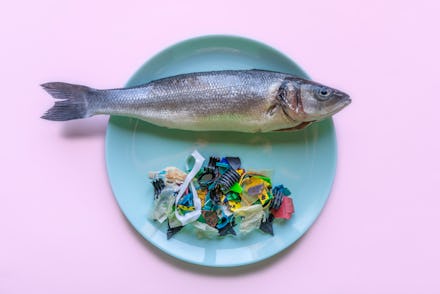Scientists have developed a way to see how much microplastic is inside of us

Researchers have historically found it very difficult to detect microplastics inside humans and other living creatures. Now, two different studies, one focused on fish and the other on humans, have developed novel solutions to that problem. In one study, published last week in the journal Environmental Science & Technology, a team of Australian researchers created a new microplastic testing method for seafood, and found the pollutant in every sample tested. And on Monday, a team from Arizona State University presented their new method of detecting plastic in human organs during an American Chemical Society meeting. Both studies are a step forward in understanding where microplastics go and how they can affect our bodies.
Microplastics aren't new, but they are a modern problem stemming from our rampant use of plastic products. When thrown away, plastic breaks down into microscopic pieces that animals and humans ingest. What happens when we consume plastic is still a mystery, but learning how to detect it in our environment and bodies in the first place is a crucial step toward understanding.
Detecting microplastics in seafood
The Australian study involved pulling samples of five types of popular seafood from a local market. The scientists purchased raw wild blue crabs, wild squid, wild sardines, farmed tiger prawns, and farmed oysters. Their new testing method found microplastics in every single sample. Out of all the seafood groups, sardines had the most plastic content with 2.9 milligrams each.
"For comparison, 30 mg is the average weight of a grain of rice," explained lead author Francisca Ribeiro in a press release.
The amount of plastic in sardines may seem small, but having the ability to detect such small amounts is a really good thing, as future research will be able to accurately calculate exactly how much plastic we consume from our food and water.
The new method was also effective in testing for five types of plastic at the same time. The plastics in the seafood consisted of the same types used to make plastic packaging materials and synthetic clothing.
Detecting microplastics in human tissue
The study by researchers from the University of Arizona is actually somewhat similar to the Australian study. The U.S. team tested a new method of detecting microplastic in human organs by taking 47 pieces of lung, liver, spleen, and kidney tissues from a tissue bank. Then, they added microplastic particles to the samples.
The new method successfully found the microplastics in every sample. The test was also effective in figuring out what types of plastic were in each tissue, such as PET and BPA. The U.S. Environmental Protection Agency considers BPA a chemical of concern due to its estrogen-like make up, which it worries can impact the development of children.
Although microplastics were added to the samples in this study, the researchers believe it's only a matter of time before scientists can use techniques like theirs to find plastic in people.
"It would be naive to believe there is plastic everywhere but just not in us," Dr. Rold Halden told The Guardian. "We are now providing a research platform that will allow us and others to look for what is invisible — these particles too small for the naked eye to see. The risk [to health] really resides in the small particles."
"We never want to be alarmist," added team member Varun Kelkar, "but it is concerning that these non-biodegradable materials that are present everywhere [may] enter and accumulate in human tissues, and we don't know the possible health effects."
The team is moving on to detect plastics within other tissues from the donor bank that weren't purposefully contaminated with microplastics.
"Once we get a better idea of what's in the tissues, we can conduct epidemiological studies to assess human health outcomes," Kelkar explained. "That way, we can start to understand the potential health risks, if any."